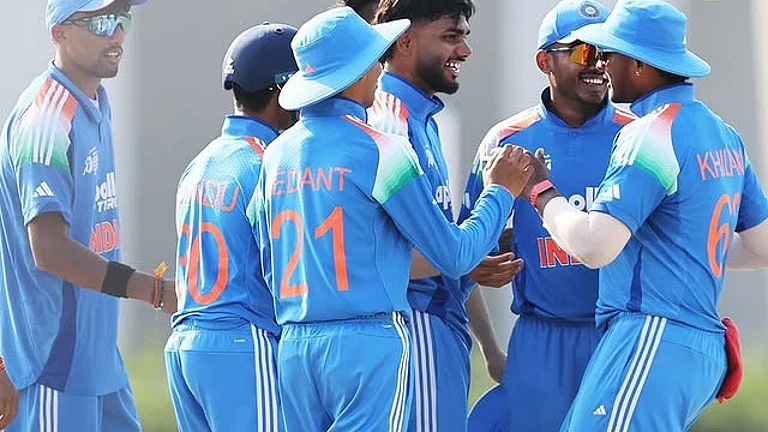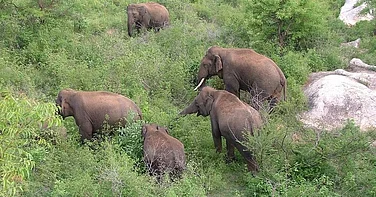AK Ramanujan, in his essay, Three Hundred Ramayanas: Five Examples and Three Thoughts on Translation, cites a folk narrative. This story revolves around Hanuman’s quest to find the lost gem ring of Lord Rama in the netherworld. Hanuman encounters the chieftain of the demi-world and the king of the ghostly beings who presents him numerous rings in a vessel, claiming all those rings belonged to Lord Rama. The king of the ghostly beings explains to the bewildered Hanuman: “This vessel contains variegated rings that appertained to various incarnations of Rama. As soon as one avatar accomplishes its objective and expires, that ring is being dropped down. I collected all the rings and kept them intact.” Then the king asks Hanuman to identify the ring which he reckoned as his Lord’s. The king also informs Hanuman that his Lord Rama had designated Lava and Kusha to be the heirs and immersed himself in the river Sarayu.
There are umpteen social and cultural makeovers of Rama and Sita, similar to the multiple accumulations of rings mentioned in the above story. Texts and subtexts differ from author to author, akin to the oral traditions. All major characters, including both Rama and Sita, are portrayed as kaleidoscopic incarnations in various texts/oral narratives with revamped colours and characteristics. As a matter of fact, all such oral/verbal narratives are nothing but tiny tributaries destined to merge into the larger river called the literature of the Ramayana.
Chandrabati Ramayana
The Ramayana is like a large tree that never stops growing. There are many instances of construing the grand narratives of the epic, including Valmiki’s Ramayana, and bringing about novel interpretations/distinct sub-texts. Among them, the Ramayanas portrayed by the women or portraying the womanhood that rebelled and refuted the male-dominant mainstream versions of the epic, deserve special mention. They substantiate that the Ramayana is not only the ayana (journey/way) of Rama, but of Sita (Sitayana) too!
Chandrabati Ramayana, penned by a rural woman named Chandrabati during the 16th century, who lived in Mymensingh village in east Bengal, is an illuminating illustration of this. It is in the form of a private diary jotted down as if for her own personal delectation. Even though the masculinity of the scholarship of that period completely neglected it, Chandrabati Ramayana survived the test of time through oral traditions. It is a spectacular endeavour to deconstruct the Ramayana from the woman’s perspective. Bangla folk songs used to commence with an appeal, “shuno sarbajano” or “shuno sabhajano” as per the normal folk conventions, whereas this book’s opening appeal—“shuno sakhijano”—exclusively addresses the women folk.
Sita is a stout symbol of womanhood, repressed and neglected by the male imperium in Chandrabati Ramayana. To the dismay of the dominant gender, she speaks like a modern feminist with ferocious guts!
For instance, let’s quote a couple of penetrating remarks by Sita from Chandrabati Ramayana in different contexts: “I have heard the moaning of millions of women. The hapless lamentations of millions of women who had lost their husbands and children by the hands of fellow men.” “I do not know who my father or mother is. I do not know who my brothers are. I have been floating and flowing from one bank of the river of life to the other shore, along with the current, like a selfless portion of duckweeds. Today I am here in this thapovan (monastery); neither me nor you know where I would be found tomorrow.” This author had never come across any other Sitas anywhere else, who speaks with such blatant conviction and a vitalised worldview.
There is a surprising intervention by the poet herself in Chandrabati Ramayana, where she confronts and assesses Rama directly. She questions Rama’s integrity as a husband as well as a man, who discarded Sita for the accusations made by his sister. She criticises Rama very severely and even blames him because it was only through his inefficacies that the Kingdom of Ayodhya got degenerated.
Chandrabati Ramayana has no traces of any man with regard to the birth of Sita. Sita was born to Mandodari; but Ravana was not her father! That part of the narrative may be summed up like this: “Ravana had collected and stored the blood of rishis (saints) in a box. His plan was to utilise the hoarded collection of blood as the dark venom, which will eliminate the immortality of the gods so that he could control the world. Ravana’s wife Mandodari, frustrated with her husband who was dating the heavenly divas whom he stole from the world of gods, decided to end her life. Assuming it was poison, she drank the blood. But astonishingly she became pregnant, instead of dying! She delivered an egg after some months. Ravana decided to destroy the egg as the wise men of Lanka prognosticated that the egg contained the eliminator of the rakshasa race. Mandodari saved the egg by storing it inside a golden trunk and dropping it in the ocean. Madhab Jalia, a poor fisherman, got the trunk which was floating in the Bay of Bengal. His wife Sata took care of the egg and worshipped it. They became rich due to the benevolence of Lakshmi, the goddess of prosperity, dwelling inside the egg. One day she had a divine dream, asking her to present the egg to King Janaka, which she obeyed. As per her request, Janka named the girl born from the egg as Sata and reared her up”.
Kannada Folk Version
Contrary to this narrative, a Kannada folk ballad collected by Rama Gowda, states that Sita is the daughter of Ravana. And very ironically, it is Ravana himself, not Mandodari, who conceived Sita! He becomes pregnant after deliciously eating a sweet mango presented by Shiva. The ballad chronicles in detail the gradual development of his pregnancy, the pain and shame he suffered in those days and the incredible delivery of baby Sita through his sneezing. According to this version of the Ramayana, Ravana is a wicked wanton who even lusts for his own daughter.
Sita’s birth, growth and death are depicted in different designs in the folk versions of the oppressed castes’ Ramayana. Nonetheless, Sita is one of the most favourite characters for the folk singers. It may be assumed that they would have sung the hyperbolic episodes of Sita’s life with poetic endowments, emphasising the emotional and sensational segments to enthral the audience, which gradually might have become seasoned interpretations and beliefs.
Seethayanas of Wayanad
This author has gathered a huge collection of oral traditions of the Ramayana prevalent among the tribal communities in Wayanad district of Kerala, as part of his doctoral research. Among these numerous versions, the Ramayana of the Adiya tribal community and the Ramayana of the Chetti Dalit community are the most significant accounts. In both these editions, the events of the Ramayana story are mainly hosted by the highlands of Wayanad. The goosebump incidents of the later stage of Ramayana, including the vanavasam (exile); abduction of Sita by Ravana; and her entry into the heart of the earth are predominantly portrayed in those folk perspectives. It’s worth mentioning that Sita is the protagonist in these Ramayanas.
I had carried out my research work and collected the Ramayana narratives principally among the Adiya, Mullakuruma, Paniya and Kurichya tribal communities and the Wayanadan Chetti, Mandadan Chetti, Edanadann Chetti and Pathiya Dalit communities of Wayanad. Ramayana stories that are customary among the temple-centered Brahmanical communities also were part of my studies.
Adiya Ramayana
It’s a custom and practice among the Adiya tribal community to sit together to recount and listen to stories. During those years, I had encountered a number of master storytellers among them—Mathai Vaidyar of Thrishileri village, noted Gaddika ritual artist, P K Kalan, M P Kalan, P K Kariyan—to name a few. Even though all the above-mentioned chieftains belong to the same tribal community, they all differ in their renditions.
The Ramayana events, according to the Adiya Ramayana, chiefly occur in Wayanad district and in Coorg, an adjacent region of Karnataka. As per the Adiya Ramayana, Ayodhya and Lanka are neighbourhoods separated by a river. Sita is naturally an Adiya tribal woman here. Rama, Lakshmana and Hanuman are obviously under the dominant status of the tribal gods, including Sidhappan, Nanjappan and Mathappan.
In an exclusive rendition of the Adiya Ramayana, Rama, Lakshmana and Hanuman are tied to a tree and brought to trial in the tribal court. The gods of the clan cross-examine them with fierce questions about the moral legitimacy of deserting his pregnant wife in the barren jungle, without procuring his responsibilities as a husband. Rama, who succumbs to the stringent questions, admits his mistakes and reaccepts Sita and Lava and Kusha. Such a crucible cannot be witnessed in any other texts of the Ramayana. Furthermore, the Adiya Ramayana doesn’t host any forms of wars either.
The Adiyas, along with numerous fellow tribal communities in Kerala, are by and large landless clans who are subject to extreme poverty and excruciating exploitation. Hence, the Adiya Ramayana meticulously problematises the land crisis and the related agonies of the tribe—in between their Ramayana chronicles. The place and period of Mathai Vaidyar’s renditions of the Ramayana are very contemporary. The backdrop and topography of the stories are also precisely as per his regional acquaintance, confined in and around Wayanad district.
Sita, who had met Ravana before meeting Rama, travelled to Lanka by a bullock cart by her own will in the Adiya Ramayana. She was born in Pulpally village in Wayanad and had to migrate to another hamlet by climbing up and down the mountains, for the local God Pakkathappan commanded her to vacate Pulpally, which he claimed to be his possession. This narrative resembles the life of a tribal woman who is evacuated by her landlord.
Wayanadan Chetty Ramayana
Wayanadan Chettis, one of the Dalit communities in Wayanad district of Kerala, also cherish the localised oral folk versions of the Ramayana and boast of their cultural heritage. Noted historian Rao Bahadur Gopalan Nair deduces their lineage from the border districts of Tamil Nadu and Karnataka. Since the migrant communities may tend to fancy or interpolate virgin/improvised archetypes and legends to glorify the newly ascent land, and to assimilate with the native hegemony, the folk traditions of the epic prevalent among them may be of the offspring of the same. They might also have replanted the Ramayana stories from their ancestors’ faith to the unearthed habitat of Wayanad.
Similar to the Adiya Ramayana, Sita is the protagonist in the Wayanadan Chetty Ramayana too. Even though the period here is precisely TretaYuga, the events are occur in the remote meadows of Wayanad, as if in a surrealist transformation of time and place. With infallible accuracy, the villages of Wayanad have been incorporated into the Ramayana imaginations of the Chettis. A village pool called Sita Kulam/Kanneer Thadakam (literally means a lake formed by the tears of Sita) and a village called Ashramam Kolli (claimed to be the monastery of Valmiki) are some of the examples. There are many varied oral narratives of the Ramayana among the Chettis. In some versions, Lava and Kusha are wedded to the native ladies of Wayanad.
Lava and Kusha had protected the villagers of Ariappalli, near Pulpally, from the asuras, who kidnap the local maidens. When in one similar incident Kusha rescued Erumappalli Chetty’s daughter, Chandika Devi, from the asuras, he got married to her and Lava tied the knot with her sister Sunita Devi.
Athirukalan, Arupuli, Thampuratti and Bammathan—the traditional goddesses of the Wayanad Chettis—also share the stage with the Ramayana characters here. When Lava and Kusha captured Rama’s horse, Hanuman was informed about the incident by those goddesses of the jungle!
It’s very important to editorialise that the Ramayana had never been a single text with a sole manifestation. Pluralistic renditions including that of the Hindu, Buddhist, Jain, Muslim, Brahmanical, Dalit, tribal and feminist adaptations of the Ramayana are available. Interestingly, even such polychromatic narratives also contain contrasting versions of the many faceted epic.
(This appeared in the print as 'The Other Ramayanas')
(Translated by K C Shaijal)
Azeez Tharuvana is assistant professor, Farook College, Kozhikode District





















